Mosquitoes and other bugs are usually seen as nuisances to be swatted away, but fashion designer Emma Bell turned them into her muses during her stint at an artist-in-residence program in New Taipei City.
The eight-piece collection My Friend the Mosquito is the result of London-based Bell’s three months working in Sijhih’s (汐止) Dream Community (夢想社區), a New Taipei City neighborhood that organizes regular cultural events. Bell’s creations were inspired by insects native to Taiwan and feature her trademark kaleidoscopic palette of brilliant colors, non-traditional materials and layering of different needlework techniques, including hand-worked embroidery, beading and three-dimensional appliques.
While at the Dream Community, Bell held costume-making workshops for residents, including members of volunteer storytelling team Sijhih Dong Tai Reading Association (汐止動態閱讀協會). The group gave Bell a reference book filled with illustrations of Taiwanese butterfly and moth species that served as the launching point for her final collection.
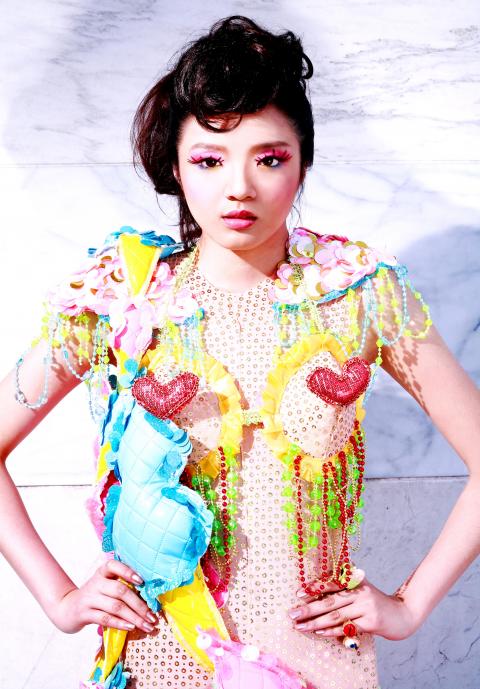
Photo Courtesy of Chiu Ching-ying
“It was really so colorful. I’d never seen anything like that before,” says Bell, who already had insects on her mind because she was constantly fending off mosquitoes. “I thought it would be interesting to recreate the patterns they have on their wings and the different sort of shapes, but in a more surreal way.”
One minidress is covered in large overlapping holographic pailettes in shades of purple, lavender, teal, royal blue and turquoise. The cool colors contrast with swaying epaulettes of neon green plastic beads and a puffy pink heart-shaped fabric brooch. A flesh-colored mesh body suit has small wings set over each shoulder layered with the same pailettes in iridescent pink.
Bell’s arrival in Taiwan coincided with the Lantern Festival, and one of her pieces for My Friend the Mosquito borrows its construction from lantern-making techniques. The skirt is made from a bamboo frame layered with papier-mache, studded with tiny LED lights and complemented with an embroidered fabric bodice.
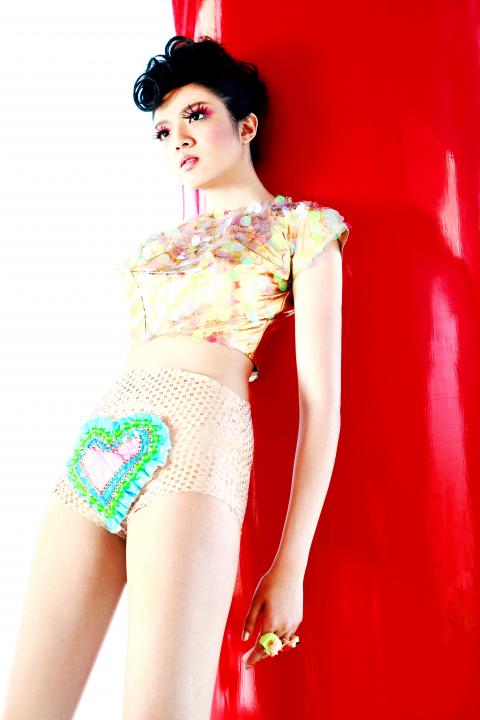
Photo Courtesy of Chiu Ching-ying
“With all of my work, whether I am at home in the UK or abroad, I always like to have an influence of whatever my surroundings are,” Bell says. “I keep a journal and sketchbooks from day one and I never throw anything away, papers or wrappers or anything.”
My Friend the Mosquito’s final photo shoot took place at the Chiang Kai-shek Memorial. Bell had become enraptured with the colors and shapes of the plaza’s buildings and would often return to observe the architecture in different weather and lighting conditions. Taipei-based photographer Chiu Ching-ying came up with a concept for the photographs that subtly incorporated the landmark while putting the focus on Bell’s playful, richly detailed designs.
“When visitors photograph the Chiang Kai-shek Memorial’s plaza, they usually take landscape shots,” Chiu says. “We wanted to find details and backdrops that insiders would be able to recognize right away, without explanation, and that would not compete with Emma’s over-the-top pieces.”
Bell’s stay in Taiwan was the final stop in an 18-month tour of artist residency programs that included stays in Vienna and Mino, a small Japanese town known for traditional papermaking. Before her year-and-a-half abroad, Bell showed collections in three London Fashion Weeks and created a line of clothing and accessories for Irregular Choice, a UK brand known for its offbeat footwear. She yearned to travel and collaborate with artists in different countries, but could not figure out a way to do so until she stumbled upon information about Austria’s quartier21 artist residency program. Her Vienna sojourn was immediately followed by her trips to Japan and Taiwan.
“I got to work with a lot of different people, be involved in a different scene and create a project that was specific to where I was at the time,” Bell says.
While in Sijhih, Bell also held regular workshops for Dream Community residents, including lantern garment-making classes. Her diverse group of students ranged from members of an elementary school samba band to an elderly man who wanted to create a costume based on Guan Yu (關羽), the God of War, to wear with stilts.
After the workshops were over for the day, Bell explored Taipei. One favorite haunt was the neighborhood surrounding Yongle Fabric Market (永樂市場), where Bell combed craft stores for items to add to a bag filled with trimmings, beads, glitter, scraps of paper and bits of fabric collected over the course of her design career for use in her creations.
“I always loved bright, unusual color combinations,” Bell says. “I’ve always been interested in colorful, sparkly things, things that wouldn’t usually work together.”
Other places in Taipei Bell enjoyed during her wanderings included the neighborhood surrounding Zhongxiao Fuxing MRT Station (忠孝復興捷運站), Huashan 1914 Creative Park (華山1914) and the Shung Ye Museum of Formosan Aborigines (順益台灣原住民博物館).
“Even when you walk down a quiet street in Taipei, it’s colorful,” Bell says. “You might just see a poster in the window, and it’s always so colorful. There is a lot to take from it.”
For more information visit www.emma-bell.com.
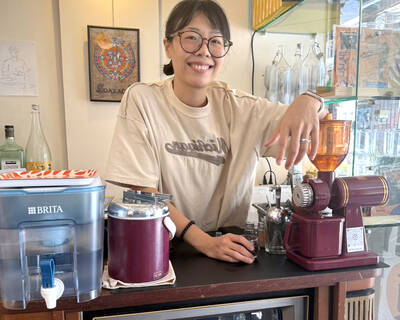
Cheng Ching-hsiang (鄭青祥) turned a small triangle of concrete jammed between two old shops into a cool little bar called 9dimension. In front of the shop, a steampunk-like structure was welded by himself to serve as a booth where he prepares cocktails. “Yancheng used to be just old people,” he says, “but now young people are coming and creating the New Yancheng.” Around the corner, Yu Hsiu-jao (饒毓琇), opened Tiny Cafe. True to its name, it is the size of a cupboard and serves cold-brewed coffee. “Small shops are so special and have personality,” she says, “people come to Yancheng to find such treasures.” She

The low voter turnout for the referendum on Aug. 23 shows that many Taiwanese are apathetic about nuclear energy, but there are long-term energy stakes involved that the public needs to grasp Taiwan faces an energy trilemma: soaring AI-driven demand, pressure to cut carbon and reliance on fragile fuel imports. But the nuclear referendum on Aug. 23 showed how little this registered with voters, many of whom neither see the long game nor grasp the stakes. Volunteer referendum worker Vivian Chen (陳薇安) put it bluntly: “I’ve seen many people asking what they’re voting for when they arrive to vote. They cast their vote without even doing any research.” Imagine Taiwanese voters invited to a poker table. The bet looked simple — yes or no — yet most never showed. More than two-thirds of those
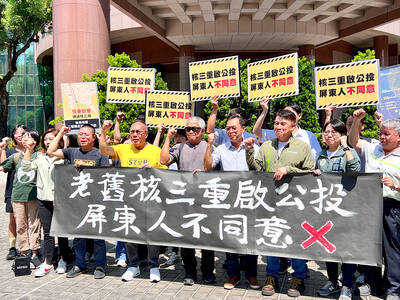
In the run-up to the referendum on re-opening Pingtung County’s Ma-anshan Nuclear Power Plant last month, the media inundated us with explainers. A favorite factoid of the international media, endlessly recycled, was that Taiwan has no energy reserves for a blockade, thus necessitating re-opening the nuclear plants. As presented by the Chinese-language CommonWealth Magazine, it runs: “According to the US Department of Commerce International Trade Administration, 97.73 percent of Taiwan’s energy is imported, and estimates are that Taiwan has only 11 days of reserves available in the event of a blockade.” This factoid is not an outright lie — that
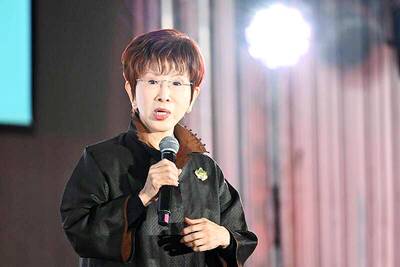
Former Chinese Nationalist Party (KMT) chairwoman Hung Hsiu-chu’s (洪秀柱) attendance at the Chinese Communist Party’s (CPP) “Chinese People’s War of Resistance Against Japanese Aggression and the World Anti-Fascist War” parade in Beijing is infuriating, embarrassing and insulting to nearly everyone in Taiwan, and Taiwan’s friends and allies. She is also ripping off bandages and pouring salt into old wounds. In the process she managed to tie both the KMT and the Democratic Progressive Party (DPP) into uncomfortable knots. The KMT continues to honor their heroic fighters, who defended China against the invading Japanese Empire, which inflicted unimaginable horrors on the